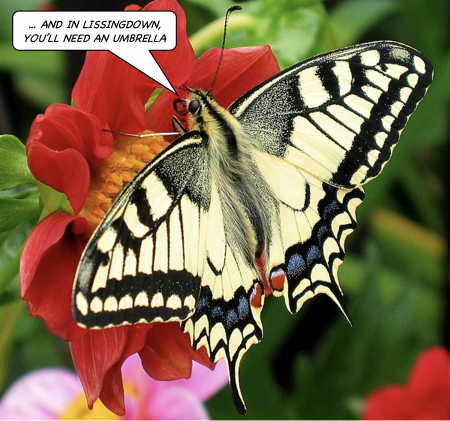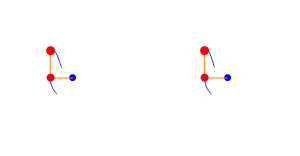Butterfly effect: Difference between revisions
Amwelladmin (talk | contribs) No edit summary |
Amwelladmin (talk | contribs) No edit summary |
||
| (8 intermediate revisions by the same user not shown) | |||
| Line 1: | Line 1: | ||
{{a|devil| | {{a|devil| | ||
[[File: | [[File:weather butterfly.png|450px|thumb|center|Ein schmetterling, gestern]] | ||
}}The [[butterfly effect]] is a much misunderstood | }}The [[butterfly effect]] is a much misunderstood metaphor from chaos theory: that the behaviour of a [[complex system]] is highly susceptible to its initial configuration, and small differences in that initial state — for example, the flapping of a butterfly’s wing in an Amazon rainforest — may have massive impact on how the [[Systems theory|system]] then behaves in a difference place at a different time— say, a hurricane occurring a week later in Manila. History depends on apparently insignificant things. | ||
This is ''not'' the same as saying, as people are prone to, that “a butterfly flapping its wings in the Amazon causes a hurricane in | This is ''not'' the same as saying, as people are prone to, that “a butterfly flapping its wings in the Amazon causes a hurricane in the Philippines”. | ||
People who not only should, but do know better, can fall into this trap. “To show what a difference an initial condition can make, consider the double-jointed pendulum”. | |||
[[File:Double jointed pendulum.gif|450px|thumb|right|Double-jointed pendulums behaving badly, yesterday.]] | |||
Set off two double-jointed pendulums from an apparently identical condition and quickly their trajectories will wildly diverge, it is true. But this divergence does not derive solely from atomic differences in the initial configurations of the pendulums, but also — and over time, increasingly — from ''ongoing'' atomic differences as the pendulums continue on their periods. A micro-second into their cycle, those differences in initial condition are important. After half an hour,<ref>assuming the pendulums do not quickly come to rest as, in fact, they will do. See below.</ref> the initial condition differences account for more or less none of the differences in the ongoing behaviour of the pendulums. | |||
Furthermore, there are millions of butterflies in the Amazon, all discretely — even if not dis''creet''ly — wing-flapping, and [[Gaussian]] nature of these events will largely cancel each other out, putting butterfly wing-flapping in “Mediocristan” and not “Extremistan”.<ref>See{{br|The Black Swan}}.</ref> | The systems are [[Path-dependent|''path''-dependent]], not ''initial-condition''-dependent. The longer the the system continues the more dependent the system will be on the infinity of subsequently intervening causes. | ||
And there is another thing: unless the pendulums have perpetual motion<ref>Impossible, of course.</ref> or are ''powered'' they will, in a short time period, come to rest. | |||
Thanks to friction, loss of heat to entropy, all pendulums, and all other things in the Cosmos, tend to rest. Their initial conditions are, ultimately, irrelevant. Over time, then, even insoluble mathematical operations converge. We can see this [[Evolution by natural selection|path dependency]] to be [[Signal-to-noise ratio|''noise'']]. The signal, as signals always do, becomes clearer over time. However you start a pendulum — however different its configuration, size, weight or jointedness — it ''will end up in [[Entropy|entropic]] rest''. | |||
For a complexity theorist, the butterfly’s wing [[metaphor]] makes the point not that hurricanes ''can'' be reduced to their infinitesimal operating causes and therefore predicted, but that they ''cannot''. These systems are so [[complex]] — so ''[[Ontology|ontologically]] indeterminate'' — that it is ''theoretically'' impossible, and not just ''practically'' impossible, to predict how they will behave. | |||
Butterfly wing-flaps are discrete independent events. Unless you hypothesise some kind of spooky quantum butterfly entanglement, one butterfly flapping its wings will not make more or less likely another butterfly’s decision to do the same, let alone any of the other environmental factors that might cause a tropical storm. | |||
Furthermore, there are millions of butterflies in the Amazon, all discretely — even if not dis''creet''ly — wing-flapping, and [[Gaussian]] nature of these events will largely cancel each other out, putting butterfly wing-flapping in “Mediocristan” and not “Extremistan”.<ref>See {{br|The Black Swan}}.</ref> | |||
If individual-butterfly-wing-flapping-in-Brazil status is a material part of the [[complex system]] that generates weather systems in China, then how many other factors are as or ''more'' material? | If individual-butterfly-wing-flapping-in-Brazil status is a material part of the [[complex system]] that generates weather systems in China, then how many other factors are as or ''more'' material? | ||
Trillions. Have fun deconstructing the [[Causation|causal chain]] to see how much of a role your butterfly actually had. Just ten generations dilutes your ancestor’s genetic contribution to your DNA to 1/1024, and in the same as way there is ''no meaningful sense in which a flighty Brazilian butterfly causes Chinese hurricanes''. | |||
{{sa}} | {{sa}} | ||
*[[Complexity]] | *[[Complexity]] | ||
{{ref}} | {{ref}} | ||
Latest revision as of 14:09, 17 November 2021

|
The butterfly effect is a much misunderstood metaphor from chaos theory: that the behaviour of a complex system is highly susceptible to its initial configuration, and small differences in that initial state — for example, the flapping of a butterfly’s wing in an Amazon rainforest — may have massive impact on how the system then behaves in a difference place at a different time— say, a hurricane occurring a week later in Manila. History depends on apparently insignificant things.
This is not the same as saying, as people are prone to, that “a butterfly flapping its wings in the Amazon causes a hurricane in the Philippines”.
People who not only should, but do know better, can fall into this trap. “To show what a difference an initial condition can make, consider the double-jointed pendulum”.

Set off two double-jointed pendulums from an apparently identical condition and quickly their trajectories will wildly diverge, it is true. But this divergence does not derive solely from atomic differences in the initial configurations of the pendulums, but also — and over time, increasingly — from ongoing atomic differences as the pendulums continue on their periods. A micro-second into their cycle, those differences in initial condition are important. After half an hour,[1] the initial condition differences account for more or less none of the differences in the ongoing behaviour of the pendulums.
The systems are path-dependent, not initial-condition-dependent. The longer the the system continues the more dependent the system will be on the infinity of subsequently intervening causes.
And there is another thing: unless the pendulums have perpetual motion[2] or are powered they will, in a short time period, come to rest.
Thanks to friction, loss of heat to entropy, all pendulums, and all other things in the Cosmos, tend to rest. Their initial conditions are, ultimately, irrelevant. Over time, then, even insoluble mathematical operations converge. We can see this path dependency to be noise. The signal, as signals always do, becomes clearer over time. However you start a pendulum — however different its configuration, size, weight or jointedness — it will end up in entropic rest.
For a complexity theorist, the butterfly’s wing metaphor makes the point not that hurricanes can be reduced to their infinitesimal operating causes and therefore predicted, but that they cannot. These systems are so complex — so ontologically indeterminate — that it is theoretically impossible, and not just practically impossible, to predict how they will behave.
Butterfly wing-flaps are discrete independent events. Unless you hypothesise some kind of spooky quantum butterfly entanglement, one butterfly flapping its wings will not make more or less likely another butterfly’s decision to do the same, let alone any of the other environmental factors that might cause a tropical storm.
Furthermore, there are millions of butterflies in the Amazon, all discretely — even if not discreetly — wing-flapping, and Gaussian nature of these events will largely cancel each other out, putting butterfly wing-flapping in “Mediocristan” and not “Extremistan”.[3]
If individual-butterfly-wing-flapping-in-Brazil status is a material part of the complex system that generates weather systems in China, then how many other factors are as or more material?
Trillions. Have fun deconstructing the causal chain to see how much of a role your butterfly actually had. Just ten generations dilutes your ancestor’s genetic contribution to your DNA to 1/1024, and in the same as way there is no meaningful sense in which a flighty Brazilian butterfly causes Chinese hurricanes.
See also
References
- ↑ assuming the pendulums do not quickly come to rest as, in fact, they will do. See below.
- ↑ Impossible, of course.
- ↑ See The Black Swan.